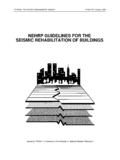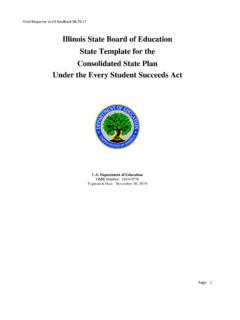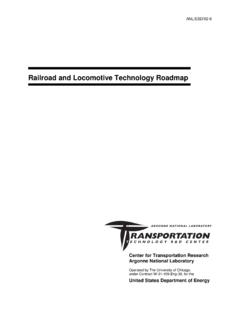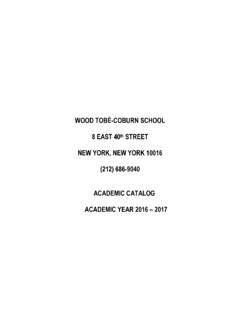Transcription of NEHRP COMMENTARY ON THE GUIDELINES FOR …
1 FEDERAL EMERGENCY MANAGEMENT AGENCY FEMA 274 /October 1997. NEHRP COMMENTARY ON THE. GUIDELINES FOR THE. seismic rehabilitation OF BUILDINGS. Issued by FEMA in furtherance of the Decade for Natural Disaster Reduction The building seismic Safety Council (BSSC) was established in 1979 under the auspices of the National Institute of building Sciences as an entirely new type of instrument for dealing with the complex regulatory, technical, social, and economic issues involved in developing and promulgating building earthquake risk mitigation regulatory provisions that are national in scope. By bringing together in the BSSC all of the needed expertise and all relevant public and private interests, it was believed that issues related to the seismic safety of the built environment could be resolved and jurisdictional problems overcome through authoritative guidance and assistance backed by a broad consensus.
2 The BSSC is an independent, voluntary membership body representing a wide variety of building community interests. Its fundamental purpose is to enhance public safety by providing a national forum that fosters improved seismic safety provisions for use by the building community in the planning, design, construction, regulation, and utilization of buildings. To fulfill its purpose, the BSSC: (1) promotes the development of seismic safety provisions suitable for use throughout the United States; (2) recommends, encourages, and promotes the adoption of appropriate seismic safety provisions in voluntary standards and model codes; (3) assesses progress in the implementation of such provisions by federal, state, and local regulatory and construction agencies; (4) identifies opportunities for improving seismic safety regulations and practices and encourages public and private organizations to effect such improvements.
3 (5) promotes the development of training and educational courses and materials for use by design professionals, builders, building regulatory officials, elected officials, industry representatives, other members of the building community, and the general public; (6) advises government bodies on their programs of research, development, and implementation; and (7) periodically reviews and evaluates research findings, practices, and experience and makes recommendations for incorporation into seismic design practices. BOARD OF DIRECTION: 1997. Chairman Eugene Zeller, City of Long Beach, California Vice Chairman William W. Stewart, Stewart-Scholberg Architects, Clayton, Missouri (representing the American Institute of Architects).
4 Secretary Mark B. Hogan, National Concrete Masonry Association, Herndon, Virginia Ex-Officio James E. Beavers, Beavers and Associates, Oak Ridge, Tennessee Members Eugene Cole, Carmichael, California (representing the Structural Engineers Association of California); S. K. Ghosh, Portland Cement Association, Skokie, Illinois; Nestor Iwankiw, American Institute of Steel Construction, Chicago, Illinois; Gerald H. Jones, Kansas City, Missouri (representing the National Institute of building Sciences); Joseph Nicoletti, URS/John A. Blume and Associates, San Francisco, California (representing the Earthquake Engineering Research Institute); John R. Jack Prosek, Turner Construction Company, San Francisco, California (representing the Associated General Contractors of America); W.
5 Lee Shoemaker, Metal building Manufacturers Association, Cleveland, Ohio; John C. Theiss, Theiss Engineers, Inc., St. Louis, Missouri (representing the American Society of Civil Engineers); Charles Thornton, Thornton-Tomasetti Engineers, New York, New York (representing the Applied Technology Council); David P. Tyree, American Forest and Paper Association, Colorado Springs, Colorado; David Wismer, Department of Licenses and Inspections, Philadelphia, Pennsylvania (representing the building Officials and Code Administrators International);. Richard Wright, National Institute of Standards and Technology, Gaithersburg, Maryland (representing the Interagency Committee for seismic Safety in Construction).
6 BSSC Staff James R. Smith, Executive Director; Thomas Hollenbach, Deputy Executive Director; Larry Anderson, Director, Special Projects; Claret M. Heider, Technical Writer-Editor; Mary Marshall, Administrative Assistant BSSC. seismic rehabilitation Project NEHRP COMMENTARY ON THE. GUIDELINES FOR THE seismic . rehabilitation OF BUILDINGS. (FEMA PUBLICATION 274). Prepared for the building seismic SAFETY COUNCIL. Washington, By the APPLIED TECHNOLOGY COUNCIL (ATC-33 Project). Redwood City, California With funding from the FEDERAL EMERGENCY MANAGEMENT AGENCY. Washington, October 1997. Washington, NOTICE: This report was prepared under Cooperative Agreement EMW-91-K-3602 between the Federal Emergency Management Agency and the National Institute of building Sciences.
7 Any opinions, findings, conclusions, or recommendations expressed in this publication do not necessarily reflect the views of the Applied Technology Council (ATC), the building seismic Safety Council (BSSC), or the Federal Emergency Management Agency (FEMA). Additionally, neither ATC, BSSC, FEMA, nor any of their employees makes any warranty, expressed or implied, nor assumes any legal liability or responsibility for the accuracy, completeness, or usefulness of any information, product, or process included in this publication. Users of information from this publication assume all liability arising from such use. For further information concerning this document or the activities of the BSSC, contact the Executive Director, building seismic Safety Council, 1090 Vermont Ave.
8 , , Suite 700, Washington, 20005; phone 202-289-7800; fax 202-289-1092; e-mail PARTICIPANTS. WOOD. PROJECT OVERSIGHT APPLIED TECHNOLOGY John M. Coil, Team Leader COMMITTEE COUNCIL Jeffery T. Miller Eugene Zeller, Chairman Robin Shepherd Thomas G. Atkinson, ATC PRINCIPAL INVESTIGATOR William B. Vaughn Gerald Jones, BSSC Christopher Rojahn Christopher Rojahn, ATC NEW TECHNOLOGIES. Paul Seaburg, ASCE PROJECT DIRECTOR Charles A. Kircher, Team Leader Ashvin Shah, ASCE Daniel Shapiro Michael C. Constantinou James R. Smith, BSSC Andrew S. Whittaker CO-PROJECT DIRECTOR. Lawrence D. Reaveley NONSTRUCTURAL. building seismic Christopher Arnold, Team Leader SAFETY COUNCIL SENIOR TECHNICAL ADVISOR Richard L.
9 Hess William T. Holmes Frank E. McClure PROJECT MANAGER Todd W. Perbix TECHNICAL ADVISOR. James R. Smith SIMPLIFIED rehabilitation . Jack P. Moehle DEPUTY PROJECT MANAGER Chris D. Poland, Team Leader ATC BOARD Leo E. Argiris Thomas Hollenbach REPRESENTATIVE Thomas F. Heausler TECHNICAL WRITER-EDITOR Thomas G. Atkinson Evan Reis Claret Heider Tony Tschanz GENERAL REQUIREMENTS. seismic rehabilitation Ronald O. Hamburger, Team Leader QUALIFICATION OF. ADVISORY PANEL Sigmund A. Freeman IN-PLACE MATERIALS. Gerald Jones, Chairman Peter Gergely (deceased) Charles J. Hookham, Lead Consultant David Allen Richard A. Parmelee Richard Atkinson (deceased). John Battles Allan R. Porush Ross Esfandiari David Breiholz MODELING AND ANALYSIS LANGUAGE & FORMAT.
10 Michael Caldwell James R. Harris Gregory L. F. Chiu Mike Mehrain, Team Leader Terry Dooley Ronald P. Gallagher Helmut Krawinkler REPORT PREPARATION. Susan Dowty Roger E. Scholl (deceased), Steven J. Eder Guy J. P. Nordenson Maurice S. Power Lead Consultant S. K. Ghosh Robert K. Reitherman Barry J. Goodno Andrew S. Whittaker A. Gerald Brady, Copy Editor Charles G. Gutberlet GEOTECHNICAL & Patty Christofferson, Coordinator Warner Howe Peter N. Mork, Illustrations FOUNDATIONS. Howard Kunreuther Harry W. Martin Jeffrey R. Keaton, Team Leader Robert McCluer Craig D. Comartin AMERICAN SOCIETY OF. Margaret Pepin-Donat Paul W. Grant William Petak Geoffrey R. Martin CIVIL ENGINEERS. Howard Simpson Maurice S.






